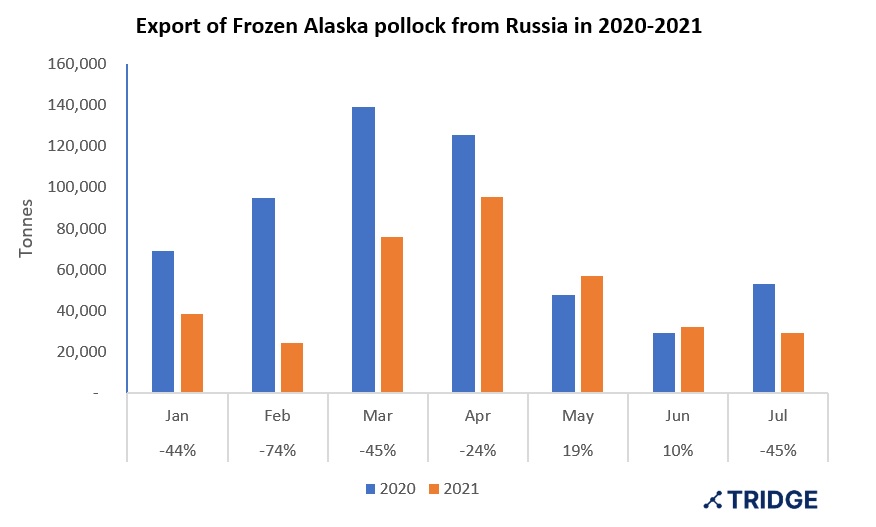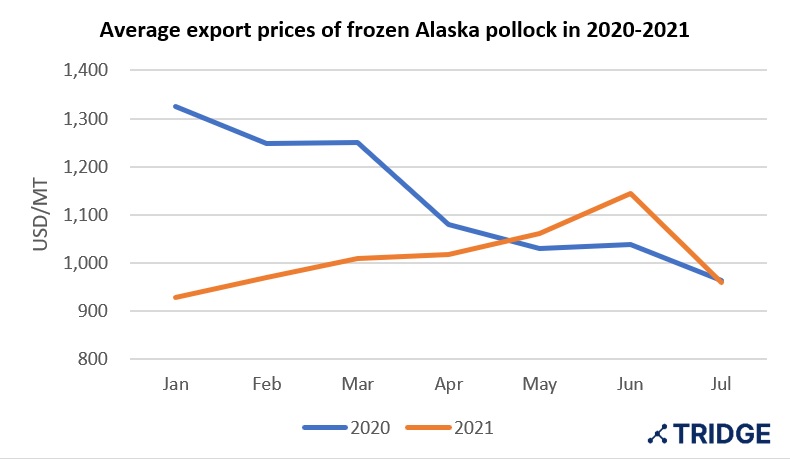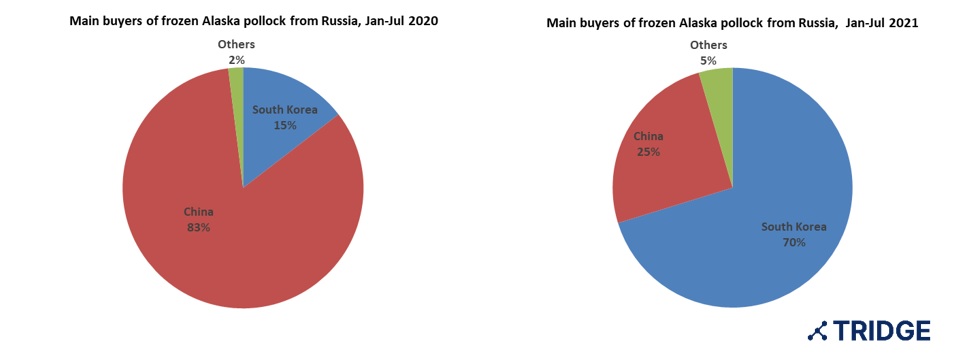Russian export of Alaska pollock: a fall in export volumes and a new leading buyer
Export on the decreasing trend
2021 has been a very tense year for the Russian exports of Alaska pollock. As Russian Customs statistics showed, the country’s shipments of Alaska pollock stood at 351,486 tonnes in the first seven months of 2021 versus 557,737 tonnes in the same period last year. The highest volume was recorded in April 2021, with shipment reaching 95,511 tonnes. However, this figure is actually 24% lower compared to the same period in 2020.

Source: Federal customs service of the Russian Federation
The decrease in the value terms was even more dramatic. The export value of frozen Alaska pollock from Russia was $357.2 million in January-July 2021, which is almost half less than what was received by the Russian exporters in the same period last year. The biggest drop was seen in the first four months of 2021 amid low prices, especially from January through May 2021. In April, the current year’s level started to catch up with the last year’s trend, thus, narrowing down the price corridor.

Source: based on Federal customs service of the Russian Federation
Export switches from China to South Korea
China has been the leading buyer of Alaska pollock from Russia for the past eight years. The buying trend has been relatively stable, with Chinese annual imports exceeding 600,000 tonnes (except for 2018, when the volumes were 570,000 tonnes). No drastic changes were expected on the market in terms of the leading buyer, as Chinese imports were much higher than the second biggest importing country, South Korea, whose imports have been fluctuating from 129,146 tonnes to 214,137 tonnes in the last 8 years.

Source: based on Federal customs service of the Russian Federation
However, the situation has made a 180-degree turn in the past seven months of 2021, with South Korea leading the way and China taking second place. The unexpected development around the COVID pandemic has interfered with the market. The story starts back in October 2020, when Chinese control authorities found traces of COVID-19 on packs of Russian frozen seafood. Since then, Chinese imports of seafood from Russia, including frozen Alaska pollock have been narrowing down. The situation worsened as Chinese ports were closed for the Russian seafood. According to the Head of the Pollock Catchers Association, Aleksey Buglak, the conditions of the delivery were narrowed to only two ports: Busan (South Korea) and Vladivostok (Russia). This has brought to the increase in logistics costs by $150-200/tonne. Such high costs are related to the fact that seafood from Russia can be exported to China only in refrigerated containers rather than in reefer vessels.
Considering the limitation of the Chinese market, frozen Alaska pollock exports from Russia found another heavy buyer, South Korea, which softened the burden of the current unfavorable situation for Russian exporters. In the first seven months of 2021, South Korean imports of frozen Alaska pollock from Russia reached 246,861 tonnes, a three-fold increase year on year. For comparison in 2020, the volume of imports of Alaska pollock from Russia was 159,761 tonnes. Apart from satisfying local consumption, South Korea has become a big hub for the further delivery of Russian pollock to Asian countries.
Sources
RBC Experts saw possible pressure from China on Russian exports (Original in Russian)
Federal customs service of the Russian Federation
ITC Trade Map


